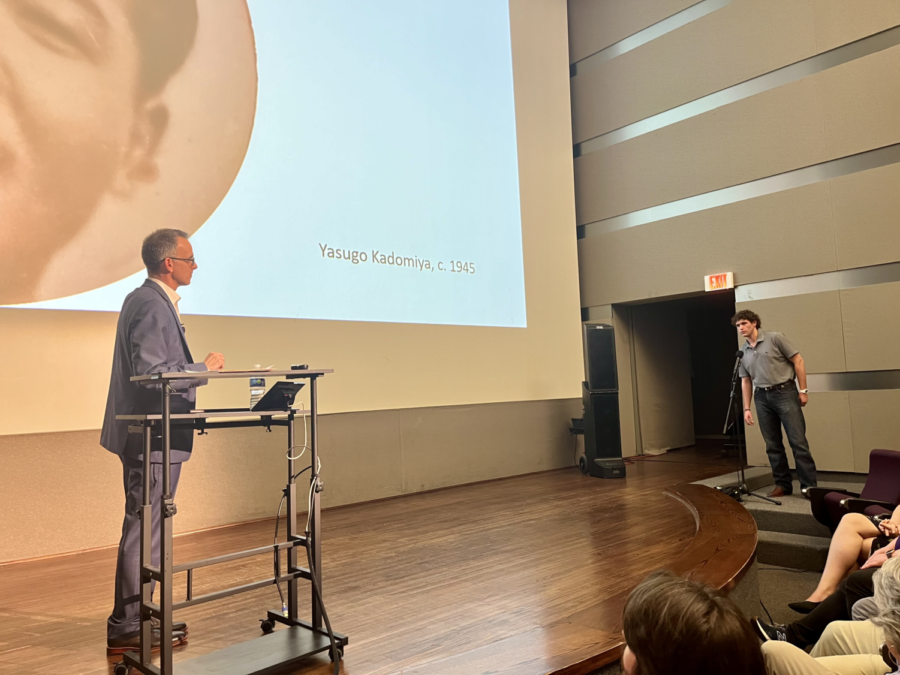Author Thomas Guglielmo lectures at the TCU history symposium
Dr. Thomas Guglielmo answers a question from first-year history major Sam Taylor at the LCpl. Benjamin W. Schmidt Symposium on War, Conflict, and Society on Thursday, March 2, 2023. (Walter Flanagin/Staff Writer)
Published Apr 18, 2023
Dr. Thomas Guglielmo gave a lecture on racial divisions within the U.S. military during World War II to a group of faithful attendees in Moudy Hall Auditorium on Thursday. Dr. Kara Vuic, who organized the LCpl. Benjamin W. Schmidt Symposium on War, Conflict, and Society, said 115 people originally signed up to attend the lecture. Despite rumors of a tornado, about 35 people, and a C-SPAN camera crew, showed up. This is the first time C-SPAN has recorded the symposium, which started in 2016. The symposium remembers Benjamin Schmidt, a former TCU history major and Marine scout sniper who died in a friendly fire in Afghanistan in 2011. Schmidt left the history department half of his life insurance policy to create a scholarship that allows a graduate student to spend a year working solely on a dissertation. Guglielmo’s lecture, based on his book, “Divisions: A New History of Racism and Resistance in America’s World War II Military,” focused on the lines that the U.S. military drew between racial groups which affected each group’s responsibilities. Among other distinctions, the racial divisions affected pay, promotion, military jobs, combat roles, honorable and dishonorable discharges, furloughs and even who could dance together. “Color lines shaped every aspect of military life,” Guglielmo said. The lecturer shared that the feeling that “color lines don’t exist in foxholes” was incredibly rare because of how few racially integrated combat units existed in World War II. First-year history major Sam Taylor explained what he learned from the symposium. “There really was a stark contrast and some pretty gross discrepancies between how these American servicemen were treated versus the ideals that they were fighting for that they didn’t even get to experience themselves,” Taylor said. Guglielmo’s book also examines the resistance to racial categorization by Japanese American, African American, Filipino American, Mexican American and white soldiers and civilian groups. Some fought for repatriation or renounced their citizenship because of the disrespect the military gave them. Others fought for desegregated units and more opportunities for combat roles and leadership positions typically only open to white soldiers. Racial divisions both politically energized and permanently scarred many of these soldiers. By the war’s end no military service branch excluded any group based on race, and veterans “infused homefront civil rights struggles with energy and moral authority” after traveling the world fighting for the United States in a struggle against threats to freedom and democracy. Guglielmo explained that the bad consequences of these racial divisions were more numerous and more significant than the good ones. They prolonged the war for multiple reasons. First, they led to inefficiencies, lowered morale and protest movements within the military. They also furthered the investment in white supremacy by reinforcing distinctions between races. This led to traumatizing many soldiers and hampering possible advancement for African American veterans who were not given equal access to the G.I. Bill. And finally, led to the deaths of countless white soldiers who were overrepresented on the front lines because African American soldiers were rarely allowed to serve in combat roles. Taylor asked Guglielmo about his research after the symposium. “He said that the most shocking eye-opening thing that he encountered during his research was how deeply embedded and entrenched the racism really was,” Taylor said. “He said he knew that it existed, but he just was completely shocked by how pervasive and expansive it was within the military as an institution.” More information on Guglielmo’s book can be found here.



